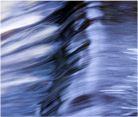|
 Small hydro is defined as the production of electricity by harnessing the power of flowing water from lakes, rivers, and streams. Small hydro is based on simple concepts. Moving water turns a turbine, the turbine spins a generator, and electricity is produced. Many other components may be in a system, but it all begins with the energy already within the moving water. Small hydro is defined as the production of electricity by harnessing the power of flowing water from lakes, rivers, and streams. Small hydro is based on simple concepts. Moving water turns a turbine, the turbine spins a generator, and electricity is produced. Many other components may be in a system, but it all begins with the energy already within the moving water.
Water power is the combination of head and flow. Both must be present to produce electricity. Consider a typical small hydro system. Water is diverted from a stream into a pipeline, where it is directed downhill and through the turbine (flow). The vertical drop (head) creates pressure at the bottom end of the pipeline. The pressurized water emerging from the end of the pipe creates the force that drives the turbine. More flow or more head produces more electricity. Electrical power output will always be slightly less than water power input due to turbine and system inefficiencies.
Head is water pressure, which is created by the difference in elevation between the water intake and the turbine. Head can be expressed as vertical distance (feet or meters), or as pressure, such as pounds per square inch (psi) or pascal (Pa) . Net head is the pressure available at the turbine when water is flowing, which will always be less than the pressure when the water is turned off (static head), due to the friction between the water and the pipe. Pipeline diameter has an effect on net head.
Flow is water quantity, and is expressed as "volume per time," such as cubic meters per second (m3/s), cubic feet per second (ft/s), or liters per minute (l/m). Design flow is the maximum flow for which your hydro system is designed. It will likely be less than the maximum flow of your stream (especially during the rainy season), more than your minimum flow, and a compromise between potential electrical output and system cost.
Measuring Head & Flow
Before you can begin designing your small hydro system or estimating how much electricity it will produce, you´ll need to make four essential measurements:
• Head (the vertical distance between the intake and turbine)
• Flow (how much water comes down the stream)
• Pipeline (penstock) length
• Electrical transmission line length (from power house to grid connection)
Head and flow are the two most important facts you need to know about your small hydro site. You simply cannot move forward without these measurements. Your site’s head and flow will determine everything about your small hydro system; pipeline size, turbine type, rotational speed, and generator size. Even rough cost estimates will be impossible until you’ve measured head and flow.
When measuring head and flow, keep in mind that accuracy is important. Inaccurate measurements can result in a small hydro system designed to the wrong specs, and one that produces less electricity at a greater expense.
|